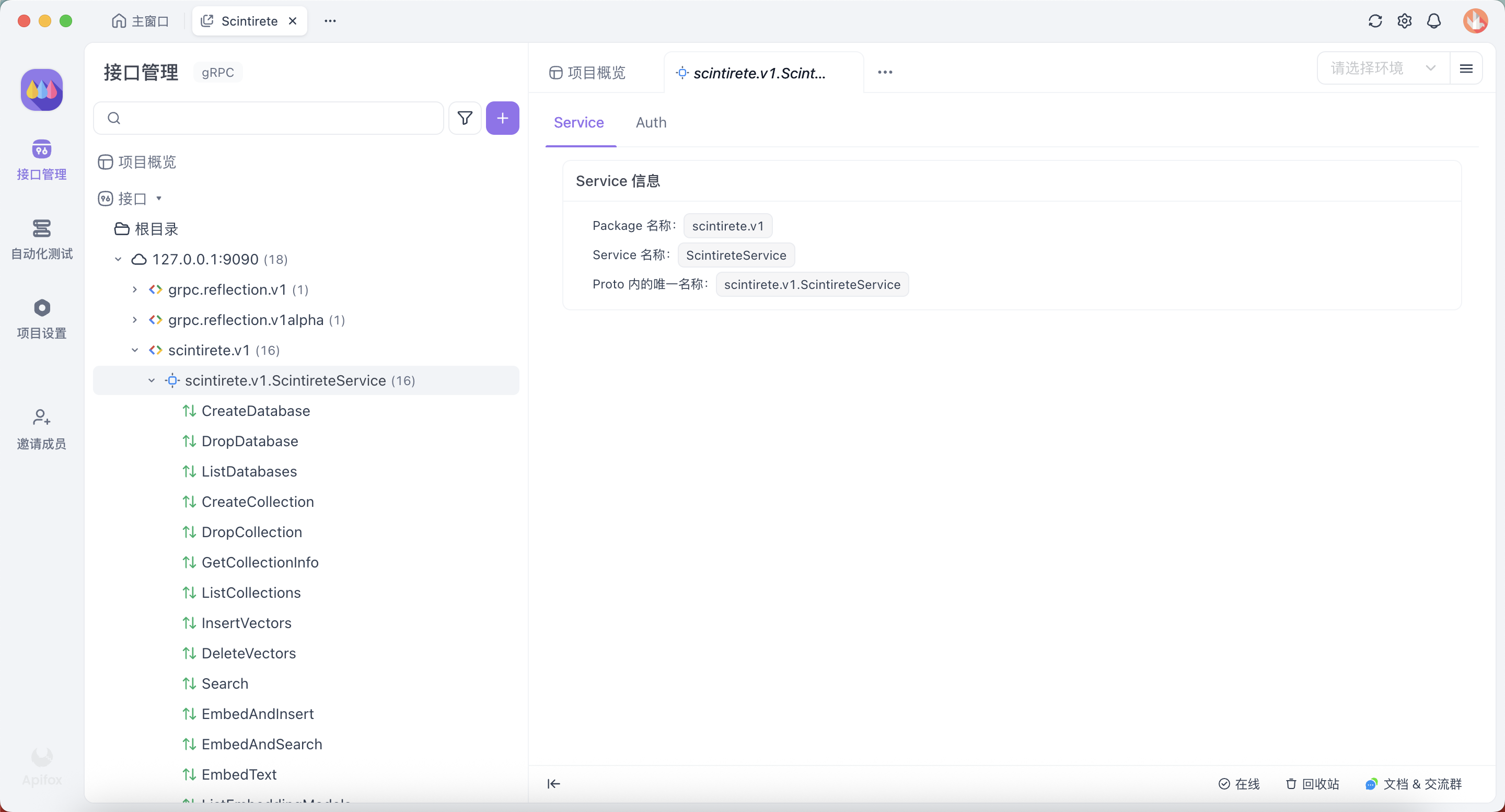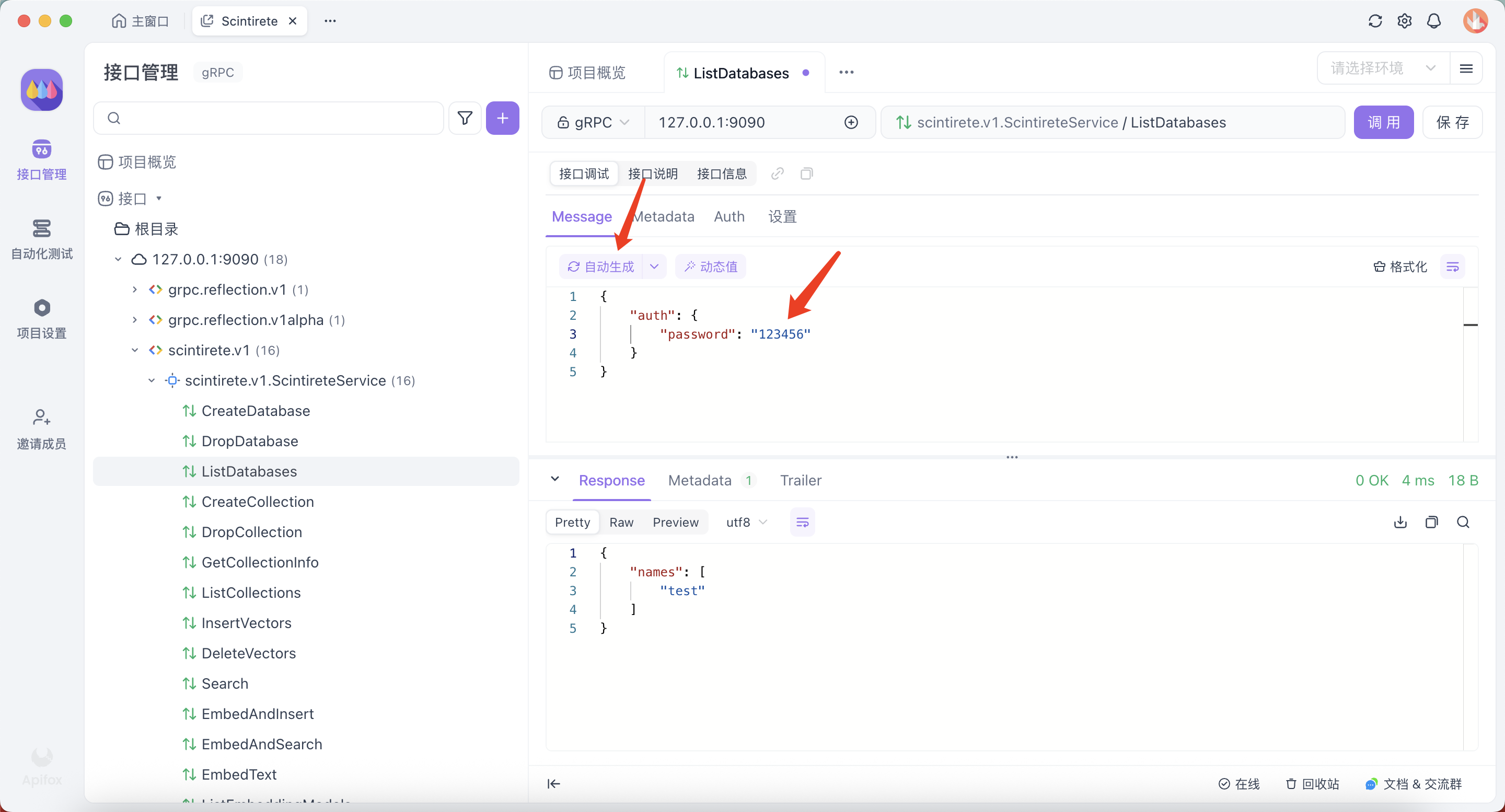Documentation
gRPC Interface Usage Guide
Scintirete provides a complete gRPC interface supporting all vector database operations. The gRPC interface offers higher performance and stronger type safety, suitable for production environments with high performance requirements.
🚀 Quick Start
Service Discovery and Reflection
Scintirete gRPC service enables server reflection, which means you can use it directly in tools that support gRPC reflection without manually importing proto files.
Supported tools:
- Apifox - Recommended, user-friendly interface
- Postman - Supports gRPC calls
- BloomRPC - Dedicated gRPC client
- grpcurl - Command-line tool
Connection Configuration
Default connection parameters:
- Address:
localhost:9090 - Protocol:
gRPC(HTTP/2) - TLS: Disabled by default in development environment, recommended to enable in production
- Authentication: Requires Bearer Token (except health check)
🛠️ Using Apifox (Recommended)
1. Create gRPC Project
- Open Apifox, create new project
- Select "Import" → "gRPC"
- Choose "Server Reflection" method
- Enter server address:
localhost:9090

2. Configure Proto

3. Service Interface Overview
After successful import, you will see the following service interfaces:

4. Call Interface

📊 Performance Comparison
Advantages of gRPC over HTTP API:
| Feature | gRPC | HTTP API |
|---|---|---|
| Performance | Faster (binary protocol) | Slower (JSON parsing) |
| Type Safety | Strong typing (protobuf) | Weak typing (JSON) |
| Streaming | Supported | Not supported |
| Code Generation | Auto-generate clients | Manual coding |
| Debugging Difficulty | Medium | Simple |
| Browser Compatibility | Requires gRPC-Web | Native support |
🛡️ Best Practices
Preparation
git clone https://github.com/scintirete/scintirete.git cd scintirete make proto-gen
In the gen/go/scintirete/v1 directory, you will see auto-generated protobuf code.
1. Connection Management
// Use connection pool var ( conn *grpc.ClientConn client pb.ScintireteServiceClient ) func init() { var err error conn, err = grpc.Dial("localhost:9090", grpc.WithInsecure(), grpc.WithKeepaliveParams(keepalive.ClientParameters{ Time: 10 * time.Second, Timeout: 3 * time.Second, PermitWithoutStream: true, }), ) if err != nil { panic(err) } client = pb.NewScintireteServiceClient(conn) }
2. Error Handling
import ( "google.golang.org/grpc/codes" "google.golang.org/grpc/status" ) func handleGRPCError(err error) { if st, ok := status.FromError(err); ok { switch st.Code() { case codes.NotFound: fmt.Println("Resource not found") case codes.PermissionDenied: fmt.Println("Permission denied") case codes.InvalidArgument: fmt.Println("Invalid argument") default: fmt.Printf("gRPC error: %v\n", st.Message()) } } }
3. Batch Operation Optimization
// Batch insert vectors (recommended) vectors := make([]*pb.Vector, 1000) for i := 0; i < 1000; i++ { vectors[i] = &pb.Vector{ Data: generateRandomVector(768), Metadata: map[string]string{ "id": fmt.Sprintf("doc_%d", i), }, } } _, err := client.InsertVectors(ctx, &pb.InsertVectorsRequest{ DatabaseName: "my_db", CollectionName: "docs", Vectors: vectors, })
🔧 Troubleshooting
Common Errors
Connection failed:
rpc error: code = Unavailable desc = connection error
- Check if server is running on correct port
- Confirm firewall settings
- Verify network connectivity
Authentication failed:
rpc error: code = PermissionDenied desc = invalid token
- Check if Bearer Token is correct
- Verify authorization header format
Parameter error:
rpc error: code = InvalidArgument desc = dimension mismatch
- Check if vector dimensions are consistent
- Verify required fields are complete
- Confirm data types are correct
Through the gRPC interface, you can build high-performance vector search applications and enjoy the advantages of strong typing and efficient binary protocols.